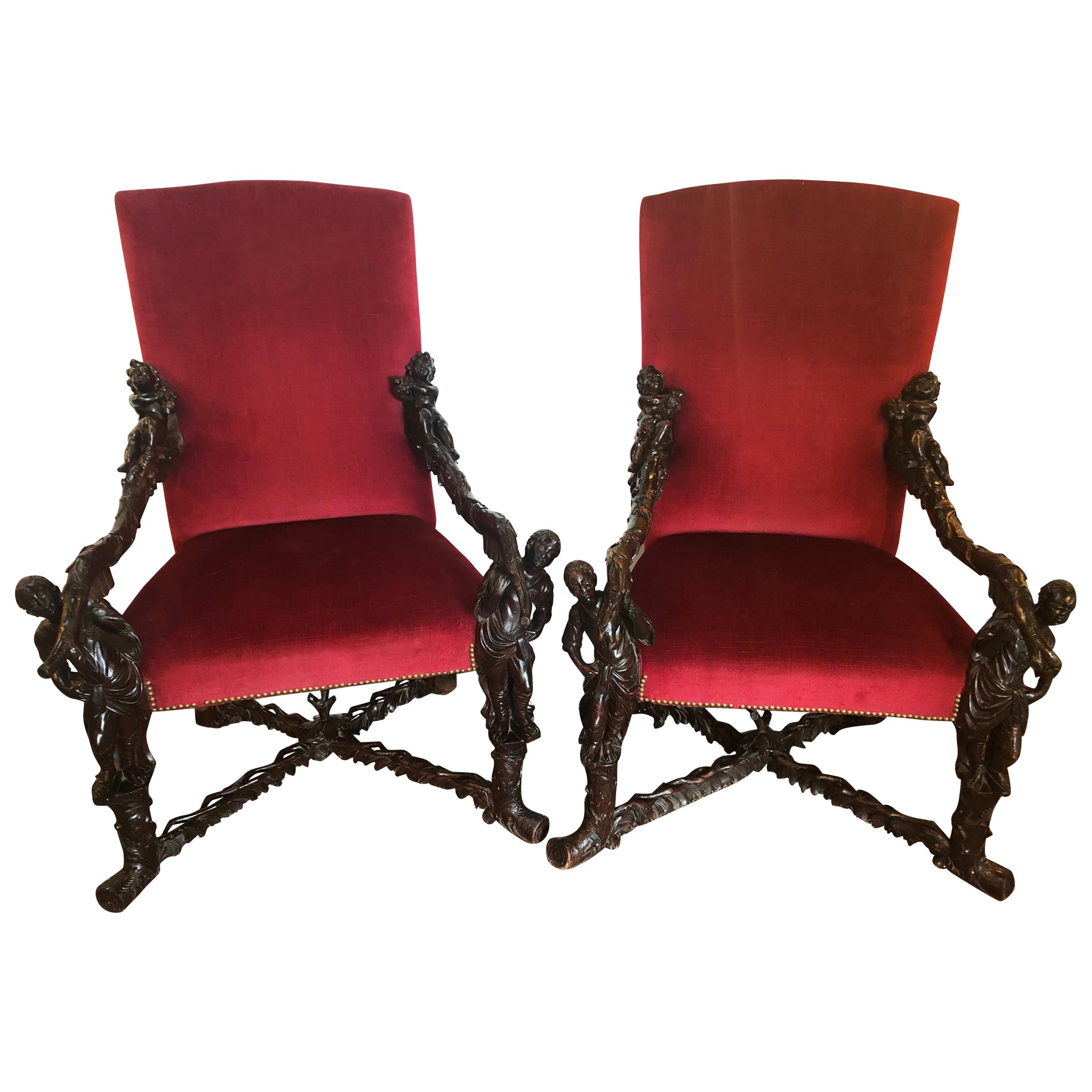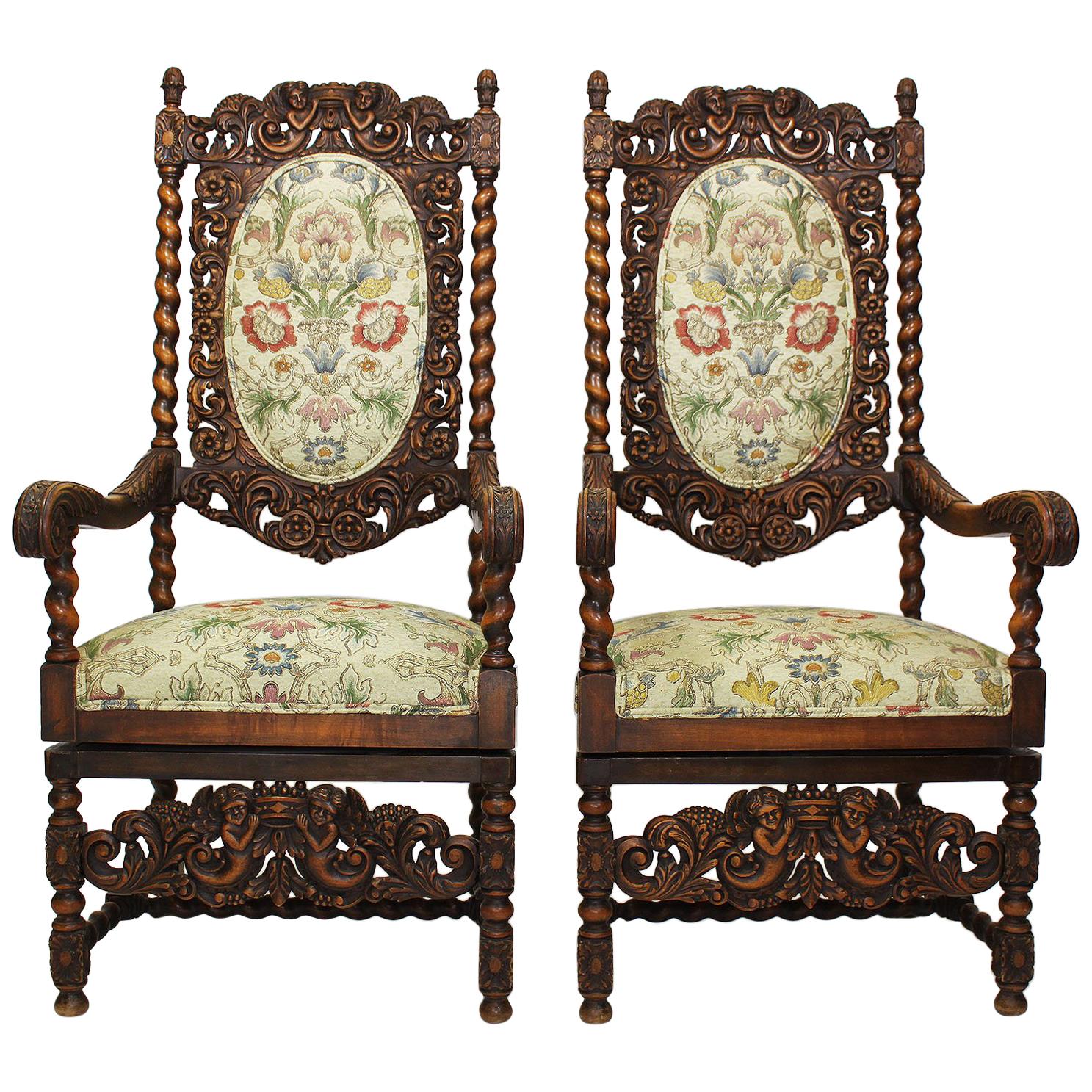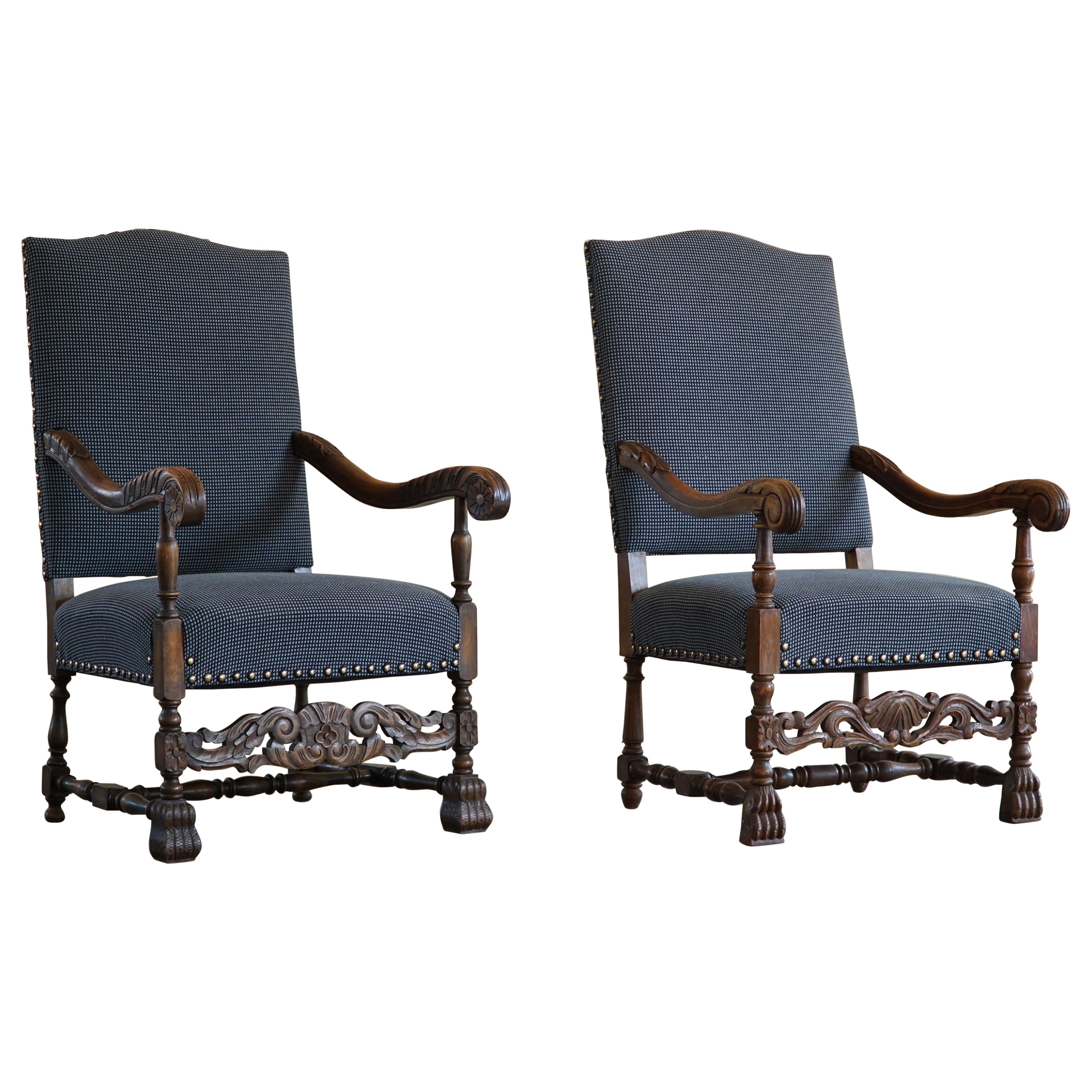Items Similar to Pair of French 19th-20th Century Baroque Style Carved Thrones Armchairs
Want more images or videos?
Request additional images or videos from the seller
1 of 11
Pair of French 19th-20th Century Baroque Style Carved Thrones Armchairs
About the Item
A pair of French 19th-20th century Baroque style carved walnut and needlepoint upholstered hall throne armchairs with raised carved armrests and fluted conjoint legs. The tapestries each depicting romantic courting scenes among trees and a floral background, circa 1890-1900.
Measures: Height: 45 inches (114.3 cm)
Width: 27 inches (68.6 cm)
Depth: 30 1/4 inches (76.9 cm)
Seat height: 18 inches (45.7 cm).
- Dimensions:Height: 45 in (114.3 cm)Width: 27 in (68.58 cm)Depth: 30.25 in (76.84 cm)Seat Height: 18 in (45.72 cm)
- Sold As:Set of 2
- Style:Baroque (In the Style Of)
- Materials and Techniques:
- Place of Origin:
- Period:
- Date of Manufacture:circa 1890-1900
- Condition:Wear consistent with age and use. Minor losses. A beautiful pair of armchairs in good original condition. Some minor fading and wear on tapestry, mainly due to age and use.
- Seller Location:Los Angeles, CA
- Reference Number:
About the Seller
5.0
Vetted Seller
These experienced sellers undergo a comprehensive evaluation by our team of in-house experts.
Established in 1982
1stDibs seller since 2016
113 sales on 1stDibs
Typical response time: <1 hour
- ShippingRetrieving quote...Ships From: Los Angeles, CA
- Return PolicyThis item cannot be returned.
More From This SellerView All
- Pair of 19th Century Baroque Revival Style Carved Walnut Throne ArmchairsLocated in Los Angeles, CAA fine pair of Italian 19th century Baroque Revival style carved walnut throne armchairs. The high-back frames with recent upholstered back and seat and open carved scrolled armrests...Category
Antique 19th Century Italian Baroque Revival Armchairs
MaterialsFabric, Walnut
- Pair of Italian 19th-20th Century Baroque Style Walnut Carved Throne ArmchairsLocated in Los Angeles, CAA fine pair of Italian 19th-20th century Baroque Revival style walnut figural carved high-back throne armchairs, each upholstered in a floral cream silk and gold fabric...Category
Antique Early 1900s Italian Baroque Revival Armchairs
MaterialsFabric, Walnut
- A Pair Italian 19th-20th Century Baroque Giltwood Carved Winged Throne ArmchairsLocated in Los Angeles, CAFine pair of Italian 19th-20th century baroque style giltwood carved winged throne armchairs, each finely carved throne with scrolls and wavy armrests, on cabriole carved feet. (New ...Category
Antique Early 1900s Italian Baroque Armchairs
MaterialsGiltwood
- Fine French 19th Century Louis XIV Style Baroque Carved Walnut Throne ArmchairLocated in Los Angeles, CAA fine French 19th century Louis XIV style Baroque Revival carved walnut throne armchair. The upholstered back and seat frame with open scrolled and carved armrests with carvings of ...Category
Antique Late 19th Century French Baroque Revival Armchairs
MaterialsFabric, Walnut
- Pair of Italian 19th Century Renaissance Style Carved Figural Throne ArmchairsLocated in Los Angeles, CAA fine and palatial pair of Italian 19th century renaissance style carved walnut figural throne armchairs. The intricately carved Baroque frames with the backrests depicting a pair o...Category
Antique Late 19th Century Baroque Revival Armchairs
MaterialsVelvet, Walnut
- Pair of Palatial Venetian Walnut Carved Mid-19th Century Baroque Figural ThronesBy Valentino BesarelLocated in Los Angeles, CAA very fine pair of palatial Venetian walnut carved mid-19th century Baroque figural throne armchairs, attributed to Valentino Panciera Besarel (Venice, 1829-1902) in the manner of Andrea Brustolon (1662-1732). The ornately carved thrones, each flanked with figures of standing males supporting a branch-carved armrests with vines. Raised on cabriolet scrolled legs. Provenance: The Castello di Giove in Umbria, Italy, circa 1870-1880. Height: 54 1/4 inches (137.8 cm.) Width: 37 1/4 inches (94.6 cm.) Depth: 32 inches (81.3 cm.) Andrea Brustolon (20 July 1662 – 25 October 1732) was an Italian sculptor in wood. He is known for his furnishings in the Baroque style and devotional sculptures. Biography He was trained in a vigorous local tradition of sculpture in his native Belluno, in the Venetian terraferma, and in the studio of the Genoese sculptor Filippo Parodi, who was carrying out commissions at Padua and at Venice (1677). He spent the years 1678-80 at Rome, where the High Baroque sculpture of Bernini and his contemporaries polished his style. Apart from that, the first phase of Brustolon's working career was spent in Venice, 1680–1685. Brustolon is documented at several Venetian churches where he executed decorative carving in such profusion that he must have quickly assembled a large studio of assistants. As with his contemporary in London, Grinling Gibbons almost all the high quality robust Baroque carving in Venice has been attributed to Brustolon at one time or another. In the Venetian Ghetto, at the Scola Levantina, Brustolon provided the woodwork for the synagogue on the piano nobile, where the carved, canopied bimah is supported on Solomonic columns, which Brustolon had seen in Bernini's baldacchino in the Basilica of St Peter's. His furniture included armchairs with figural sculptures that take the place of front legs and armrest supports, inspired by his experience of Bernini's Cathedra Petri. The gueridon, a tall stand for a candelabrum, offered Brustolon unhampered possibilities for variations of the idea of a caryatid or atlas: the familiar Baroque painted and ebonized figural gueridons, endlessly reproduced since the eighteenth century, found their models in Brustolon's work. His secular commissions from Pietro Venier, of the Venier di San Vio family (a suite of forty sculptural pieces that can be seen in the Sala di Brustolon of the Ca' Rezzonico, Venice), from the Pisani of Strà, and from the Correr di San Simeone families encourage the attribution to him of some extravagantly rich undocumented moveable furniture. Andrea Brustolon's elaborate carved furniture aspired towards the condition of sculpture, such as the Dutch bases for console tables which look like enlargements of the work of the two Van Vianens, Paulus and Adam, perhaps the greatest Dutch silversmiths of the period. These carved pieces display the baroque tendency to develop a form three-dimensionally in space. Brustolon's walnut, boxwood and ebony pieces transcend ordinary functional limitations of furniture; they are constructed of elaborately carved figures. The framework of Brustolon's chairs, side tables and gueridons were carved as gnarled tree branches, with further supports of putti and male figures carved in ebony. Backrests of the chairs, which were never touched in the rigidly upright posture that contemporary etiquette demanded, were carved with allegories of vanity, fire and music, etc. The most extravagant piece delivered for Pietro Venier was a large side table and vase-stand of box and ebony, designed as a single ensemble to display rare imported Japanese porcelain vases. The eclectic allegories include Hercules with the Hydra and Cerberus, males and reclining river-gods (see ref.). For the Correr, less extrovert chairs bear female nudes extended along the armrests. For the Pisani, he carved a suite of twelve chairs (now at the Palazzo Quirinale) with flowers, fruit, leaves and branches to symbolize the twelve months of the year. Work by Brustolon is at the Villa Pisani at Stra. In 1685 Brustolon returned to the house where he was born at Belluno, and from that time devoted himself mainly to tabernacles and devotional sculptures in walnut, boxwood or ivory. His polychromed ivory Corpus from a crucifix is in the Museo Civico di Belluno, which preserves some of Brustolon's preparatory drawings for frames to be carved with putti displaying emblems. A pair of boxwood sculptures, The Sacrifice of Abraham and Jacob Wrestling with the Angel...Category
Antique 19th Century Italian Baroque Armchairs
MaterialsLeather, Walnut
You May Also Like
- Pair of Italian 19th Century Baroque Carved Arm Throne Chairs, Figural CarvingsLocated in Stamford, CTPair of Italian 19th century Baroque carved arm throne chairs. The pair with figural carvings and putti sleeping on beds of leafs, attributed to Valentino Panciera Besarel (Venice, 1829-1902) in the manner of Andrea Brustolon (1662-1732). The ornately carved thrones, each flanked with figures of standing males supporting a branch-carved armrests with vines. Raised on cabriolet scrolled legs. Andrea Brustolon (20 July 1662–25 October 1732) was an Italian sculptor in wood. He is known for his furnishings in the Baroque style and devotional sculptures. Biography He was trained in a vigorous local tradition of sculpture in his native Belluno, in the Venetian terraferma, and in the studio of the Genoese sculptor Filippo Parodi, who was carrying out commissions at Padua and at Venice (1677). He spent the years 1678-1680 at Rome, where the High Baroque sculpture of Bernini and his contemporaries polished his style. Apart from that, the first phase of Brustolon's working career was spent in Venice, 1680–1685. Brustolon is documented at several Venetian churches where he executed decorative carving in such profusion that he must have quickly assembled a large studio of assistants. As with his contemporary in London, Grinling Gibbons almost all the high quality robust Baroque carving in Venice has been attributed to Brustolon at one time or another. In the Venetian Ghetto, at the Scola Levantina, Brustolon provided the woodwork for the synagogue on the piano nobile, where the carved, canopied bimah is supported on Solomonic columns, which Brustolon had seen in Bernini's baldacchino in the Basilica of St Peter's. His furniture included armchairs with figural sculptures that take the place of front legs and armrest supports, inspired by his experience of Bernini's Cathedra Petri. The gueridon, a tall Stand for a candelabrum, offered Brustolon unhampered possibilities for variations of the idea of a caryatid or atlas: the familiar Baroque painted and ebonized figural gueridons, endlessly reproduced since the 18th century, found their models in Brustolon's work. His secular commissions from Pietro Venier, of the Venier di San Vio family (a suite of forty sculptural pieces that can be seen in the Sala di Brustolon of the Ca' Rezzonico, Venice), from the Pisani of Strà, and from the Correr di San Simeone families encourage the attribution to him of some extravagantly rich undocumented moveable furniture. Andrea Brustolon's elaborate carved furniture aspired towards the condition of sculpture, such as the Dutch bases for console tables which look like enlargements of the work of the two Van Vianens, Paulus and Adam, perhaps the greatest Dutch silversmiths of the period. These carved pieces display the Baroque tendency to develop a form three-dimensionally in space. Brustolon's walnut, boxwood and ebony pieces transcend ordinary functional limitations of furniture; they are constructed of elaborately carved figures. The framework of Brustolon's chairs, side tables and gueridons were carved as gnarled tree branches, with further supports of putti and male figures carved in ebony. Backrests of the chairs, which were never touched in the rigidly upright posture that contemporary etiquette demanded, were carved with allegories of vanity, fire and music, etc. The most extravagant piece delivered for Pietro Venier was a large side table and vase-stand of box and ebony, designed as a single ensemble to display rare imported Japanese porcelain vases. The eclectic allegories include Hercules with the Hydra and Cerberus, males and reclining river-gods (see ref.). For the Correr, less extrovert chairs bear female nudes extended along the armrests. For the Pisani, he carved a suite of twelve chairs (now at the Palazzo Quirinale) with flowers, fruit, leaves and branches to symbolize the twelve months of the year. Work by Brustolon is at the Villa Pisani at Stra. In 1685 Brustolon returned to the house where he was born at Belluno, and from that time devoted himself mainly to tabernacles and devotional sculptures in walnut, boxwood or ivory. His polychromed ivory Corpus from a crucifix is in the Museo Civico di Belluno, which preserves some of Brustolon's preparatory drawings for frames to be carved with putti displaying emblems. A pair of boxwood sculptures, The Sacrifice of Abraham and Jacob Wrestling with the Angel...Category
Antique 1890s Italian Baroque Armchairs
MaterialsWood
- Antique Danish 19th Century Pair of Baroque Carved High Back ArmchairsLocated in Odense, DKA gorgeous pair of high back armchairs in solid oak. Hand carved by a Danish cabinetmaker in the 19th century. The overall impression is really good. These fine armchairs will co...Category
Antique Mid-19th Century Danish Romantic Armchairs
MaterialsOak
- Pair Of 19th C. Neoclassical French Carved Walnut ArmchairsLocated in Bridgeport, CTLabeled Dugard underneath the seats. With carved gadrooned pediment crest rails with center scrolled crests over burled upper backs. The curved arms with carved leafy backs and ribbe...Category
Antique 19th Century French Neoclassical Armchairs
MaterialsFabric, Walnut
- 19th Century Pair of Italian Carved Walnut ArmchairsLocated in Dallas, TXAn attractive pair of restored carved walnut armchairs, Italy, circa 19th century. Each chair features a curved crest rail, padded back and seat covered in a new sturdy cotton fabric...Category
Antique 19th Century Italian Armchairs
MaterialsBronze
- Carved Throne Armchair in Gothic Style, France, 20th CenturyLocated in Antwerp, BEAntique; Throne; Gothic Style; Medieval; 19th century; 20th century; France; Brutalist; Eclectic Design; Carved throne armchair in leather and dark wood from 20th century France. D...Category
Early 20th Century French Gothic Armchairs
MaterialsMetal
- Pair of Late 19th Century Empire Style ArmchairsLocated in Sheffield, MAThe pair of late 19th century lounge chairs are in the Empire style. The curved arms end with carved acanthus leaves. The seats and borderin...Category
Antique Late 19th Century American Empire Armchairs
MaterialsLinen, Wood
Recently Viewed
View AllMore Ways To Browse
19th Century Needlework
19th Needlework
Tapestry Baroque
Needlepoint Armchair
French Baroque Seating
Tapestry Armchairs Pair
Baroque Style Armchairs
Baroque Walnut Armchair
Baroque Walnut Armchairs
Walnut Hall Tree
Baroque Armchair Pair
Throne Upholstered
Tapestry Upholstered Armchair
Baroque Wood Armchairs
French Needlework
Baroque Flute
Style Throne Armchair
4 Carved French Armchairs





